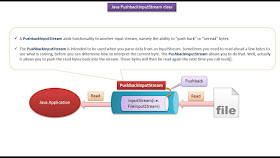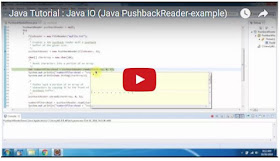PushbackInputStreamDemo.java
import java.io.FileInputStream;
import java.io.IOException;
import java.io.PushbackInputStream;
/*
* public PushbackInputStream(InputStream in, int size)
*
* Parameters:
* -----------
*
* in - the input stream from which bytes will be read.
* size - the size of the pushback buffer.
*/
public class PushbackInputStreamDemo
{
public static void main(String[] args) throws IOException
{
FileInputStream fileInputStream = null;
PushbackInputStream pushbackInputStream = null;
try
{
fileInputStream = new FileInputStream("myfile.txt");
/*
* Creates a PushbackInputStream with a pushback
* buffer of the specified size, and saves its
* argument, the input stream in, for later use.
*/
pushbackInputStream = new PushbackInputStream(fileInputStream, 8);
byte[] byteArray = new byte[10];
/*
* Reads up to len bytes of data from this input
* stream into an array of bytes.
*/
int numberOfBytesRead = pushbackInputStream.read(byteArray, 0, 5);
System.out.println("numberOfBytesRead = "+numberOfBytesRead);
System.out.println(new String(byteArray));
/*
* Pushes back a portion of an array of bytes by
* copying it to the front of the pushback
* buffer.
*/
pushbackInputStream.unread(byteArray, 0, 5);
numberOfBytesRead = pushbackInputStream.read(byteArray, 0, 5);
System.out.println("numberOfBytesRead = "+numberOfBytesRead);
System.out.println(new String(byteArray));
}
finally
{
if (pushbackInputStream != null)
{
/*
* Closing a PushbackInputStream will also
* close the Reader instance from which the
* PushbackInputStream is reading.
*/
pushbackInputStream.close();
}
}
}
}





































